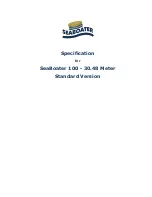
OWNER’S MANUAL
A1010 3 Cabin Segue 110V Original Dated Sept 2006.doc
Page 24 of 59
EMERGENCY TREATMENT OF CO POISONING
– CO toxicity is a life-threatening
emergency that requires immediate action. The following is a list of things that should
be done if CO poisoning is suspected. Proceed with caution. The victim may be in an
area of high CO concentration.
•
Evaluate the situation and ventilate the area if possible
•
Evacuate the area and move affected person(s) to a fresh air environment
•
Observe
the
victim(s)
•
Administer oxygen, if available
•
Contact medical help. If the victim is not breathing, perform rescue breathing
or approved cardiopulmonary resuscitation (CPR), as appropriate, until
medical help arrives. Prompt action can make the difference between life and
death
•
Investigate source of CO and take corrective action.
MARINE CO DETECTION SYSTEMS
Even with the best of boat design and construction, and scrupulous attention to
inspection, operation and maintenance of boat systems, hazardous levels of CO
may, under certain conditions, be present in interior spaces and exterior areas.
Vigilant observation of passengers for CO sickness symptoms should be
supplemented by a marine CO detection device in the accommodation space.
Detection devices should meet the requirements of ABYC A-24, Carbon Monoxide
Detection Systems on Boats.
NOTE: There are currently no known CO detectors available for permanent
installation in exterior areas.
STATIONARY OPERATION
A boat operator should be aware that dangerous concentrations of CO can
accumulate when propulsion engines and/or an auxiliary generator is operated while
the boat is stationary, especially when rafted or moored in a confined area such as
boathouses, proximity to seawalls, or proximity to other boats.
Refer drawing L46 STD-FA-0053-0 (PAGE 1 OF 4)
THE EFFECT OF SEA WALLS AND OTHER CONFINED SPACES
This figure illustrates the effects of running engine or auxiliary generator in confined
areas.
Keep engine room hatches and doors closed when operating engines, including the
generator set.
Pay attention to prevailing conditions and provide for ventilation to induce fresh air
and minimize exhaust re-entry. Orient boat to enable the maximum dissipation of CO.
Be aware that cockpit and deck drains can be a source of CO ingress into boats,
especially boats with cockpit or decks enclosed with canvas boat structures.
Summary of Contents for LePard 46
Page 60: ......
Page 61: ......
Page 62: ......
Page 63: ......
Page 64: ......
Page 65: ......
Page 66: ......
Page 67: ......
Page 68: ......
Page 69: ......
Page 70: ......
Page 71: ......
Page 72: ......
Page 73: ......
Page 74: ......
Page 75: ......
Page 76: ......
Page 77: ......
Page 78: ......
Page 79: ......
Page 80: ......
Page 81: ......
Page 82: ......
Page 83: ......
Page 84: ......
Page 85: ......
Page 86: ......
Page 87: ......
Page 88: ......
Page 89: ......
Page 90: ......
Page 91: ......
Page 92: ......
Page 93: ......
Page 94: ......
Page 95: ......
Page 96: ......
Page 97: ......
Page 98: ......
Page 99: ......
Page 100: ......
















































